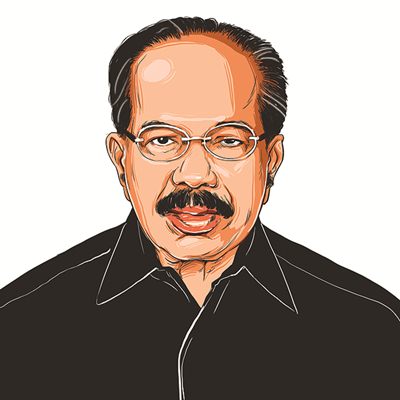Opinion Painting by numbers
The Indian economy is powering ahead,as most recent indicators reveal....
While Western economies struggle to come to grips with the problems at hand,emerging market economies,particularly those from the Asian region,continue to move ahead at a robust pace.
The years 2008 and 2009 were tumultuous for global trade. The simmering sub-prime crisis in the US in 2007,which triggered the global financial crisis in September 2008 spread its tentacles,leading to a full-blown global recession resulting in an unprecedented fall in global trade. World trade volume (goods and services) grew by only 2.8 per cent in 2008 compared to 7.3 per cent in 2007,with trade growth tumbling down month after month from September 2008 onwards.
The deepening world recession had profound impact on world output and trade,with growth of world output and trade volume of goods and services falling to (-) 0.8 and (-) 12.3 per cent respectively in 2009 according to the International Monetary Funds (IMF) World Economic Outlook (WEO) January 2010.
The crisis seems largely to have petered out in the second half of 2009 and beginning of 2010 with global trade recovering from the troughs and the appearance of green shoots,and the IMF in April even projecting a better-than-expected growth in world trade volume of 7.0 per cent and 6.1 per cent for 2010 and 2011 respectively,which is also a reflection of the higher-than-expected world output growth projections of 4.2 per cent and 4.3 per cent in 2010 and 2011 respectively. India and China have weathered the crisis with great dexterity and spearheaded the recovery. Recently,there seems to be signs of slowdown in China,but Indias growth is surging ahead.
Indias greater integration with the world economy was reflected by the trade openness indicator,the merchandise trade to GDP,which increased from 20.0 percent of GDP in 2001-02,to 34.2 in 2006-07 and further to 40 percent of GDP in 2008-09. If services trade is included,the increase is higher at 52.4 percent of GDP in 2008-09 from 26.4 percent of GDP in 2001-02,reflecting greater degree of openness.
The Indian economy is estimated to have grown by 6.7 per cent in 2008-09 following a growth of 9.2 per cent in 2007-08. The global financial crisis led to a slowdown in the Indian economy with quarterly growth at around 6 per cent in the third and fourth quarters of 2008-09 and the first quarter of the current fiscal. According to the revised estimates,GDP at factor cost at constant (2004-05) prices in the year 2009-10 has grown by 7.4 per cent,(as against 7.2 per cent in the advance estimates) over the quick estimates of 2008-09. Growth in 2008-09 was 6.7 per cent (quick estimates).
The growth rate in Q4 2009-10 GDP,estimated at 8.6 per cent,(as against the growth rate of 5.8 per cent in Q4 2008-09) shows the momentum in growth recovery. The runaway growth in capital goods,as per the IIP,during the second half (H2) of 2009-10 (in excess of 30 per cent year-on-year) indicated that the investment activity is gaining momentum.
Exports during April 2010 registered a growth rate of 36.2 per cent over April 2009. Exports witnessed a positive growth from November 2009 onwards,and for the month of February and March 2010,it registered a high growth of 34.8 per cent and 54.1 per cent respectively. Imports during April 2010 registered a high growth rate of 43.3 per cent compared to April 2009. Import growth in December 2009,January 2010 and February 2010 was 27.2,35.5 and 66.4 per cent respectively. In March 2010,imports grew by 67.1 per cent over March 2009.
Judged by the rates of savings and investment,India is now completely a part of the worlds fast-growing economies. In 2008-09 gross domestic savings as a percentage of GDP were 32.5 per cent and gross domestic capital formation was 34.9 per cent. Since these indicators are some of the strongest correlates of growth and do not fluctuate wildly,they speak very well for Indias medium-term growth prospects. As the demographic dividend begins to pay off in India,with the working age-group population rising disproportionately over the next two decades,the savings rate is likely to rise further.
In the medium term it is reasonable to expect that the economy will go back to the robust growth path of around 9 per cent. Indian exports have recorded impressive growth since November 2009. Further,infrastructure services,including railway transport,power,telecommunications and,recently but to a lesser extent,civil aviation,have shown a remarkable turnaround since the second quarter of 2009-10. The favourable capital market conditions with improvement in
capital flows and business sentiments,as per the RBIs business expectations survey,are also
encouraging.
The services sector (financial and non-financial) has attracted highest FDI inflows of 21 per cent of total FDI inflows. Computer software and hardware,telecommunication and housing and real estate accounted for nearly 8-9 per cent of total FDI inflows respectively. Increasing foreign institutional investment shows the growing confidence of investors in India. FII investment was US$ 20.3 billion in 2007-08,declined to US$ (-) 15.0 billion in 2008-09 due to global financial crisis and recession. However in 2009-10,it bounced back to US$ 29.0 billion.
Given the way our savings and investment rates are moving,we are sure that we will cross over to double digit growth rates in the next four to five years and in the process,surpass China as the worlds fastest growing economy.
In the last four years,FDI flows have totaled almost US$ 130 billion. 2006-07 (US$ 23 bn),2007-08 (US$ 34.8 bn),2008-09 (US$ 35.1 bn),2009-10 (US$ 34.2 bn). Portfolio investment too have moved up from US$ 7 bn in 2006-07 to US$ 32 bn in 2009-10. The countrys exposure to toxic assets is almost nil. Indian banks and financial institutions are robust with strong prudential norms.
The writer is Union minister for law,justice and company affairs





